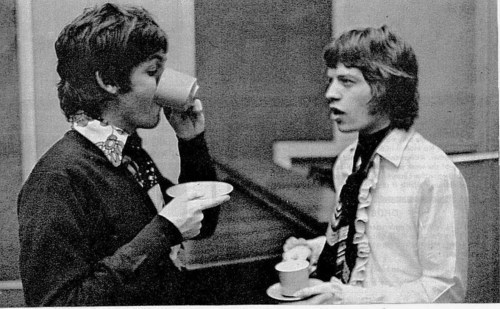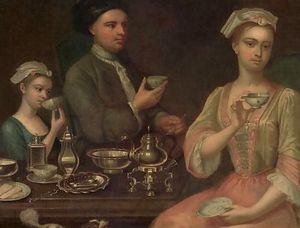“Is there any tea on this spaceship?” Arthur Dent, the Hitchhiker’s Guide to the Galaxy.
I’m sitting here with a steaming cup of inspiration at my side. An Englishman drinking tea from a porcelain cup stirred by a spoon: what could be more ordinary than that? But dig carefully into what led to this scene and you can find stories of magical transformations, global trade, empires and planet-changing events billions of years ago. Let’s start with a taste of the history of tea, the enriching elixir, the healthy pause that refreshes.
The tea bush, isn’t native to Britain1; when and why did this country get into the habit of putting its leaves into hot water?
Tea has been drunk in China for thousands of years – the plant Camellia sinensis is native there. It’s leaves are rich in caffeine, most likely to reduce damage from insects or associated fungal attacks2.
Caffeinated drinks first made a big splash in Europe in the Seventeenth Century. Coffee, sourced from the Middle East was drunk at ‘coffee houses’ alongside chocolate from the Americas and tea. Processed tea was brought direct from China by sea around Africa, a route opened up by the Portuguese the century before. Though still only available to the elite, coffee houses had an impact in many ways. As a semi-public space, typically with newspapers to hand, they were a venue for political activity: Charles II of England wanted to shut down London’s coffee houses as they contained “idle and disaffected persons” who “produced very evil and dangerous effects”. A great public outcry ensued and, not the most powerful of monarchs (his father had been executed by Parliament only 26 years earlier), Charles backed down and the seditious sipping continued. Insurance titan Lloyds of London started life as a coffee house3 around this time. Meetings of the early Royal Society, (attended by the guys who now have scientific Laws named after them: Newton, Hooke, Boyle and others) often finished up in Coffee Houses.
It’s tempting to make a link between the dramatic changes associated with this Early Modern period in history with the sudden infusion of caffeine. To drink safely in urban areas without modern sanitation you need a drink made from boiled water. Before tea and coffee became popular, this was often an alcoholic drink, wine or beer, weaker than we are used to today. It’s tempting to think of coffee and tea jolting the modern world awake one sip at a time.
For the next 150 years tea’s popularity in the west only grew. In the period leading to American independence in 1776, the British Government’s desire to monopolise (and tax) the supply of tea to its American colonies led to the Boston Tea Party and tea-drinking being seen as unpatriotic. The Tea Act, that so annoyed the patriots of Boston was passed to help the hugely influential British East India Company, who also had a monopoly on supplying tea to Britain. This, plus high taxes led to high rates of smuggling of tea (and other goods) from France via the England’s southern coast.
Tea is native to India, particularly in Assam, but it’s leaves were seen locally as a herbal medicine rather than a way to make a drink. By the 1830s the East India Company (who by now had control over most of the Indian sub-Continent) were looking for an alternative source of tea than China and recognised a suitable climate in Assam4. Initially plantings were made of transplanted Chinese plants, but the native varieties fared better. Tea plantations spread, soon taking in the area near Darjeeling and eventually spreading to Southern India and Ceylon (modern-day Sri Lanka). All these names are now also varieties of tea. By the early Twentieth Century tea drinking became popular in India itself, characteristically as milky, sweet and spicy Chai5.
By the second World War, tea was so ingrained in British culture that a regular supply of tea was seen as the second most important factor in troop morale, behind actually winning and ahead of food6. The UK government took control of world supplies of tea 7 – and assigned it first to troops, then to home front, then the rest of world. This caused problems for the Irish republic, whose tea habit was at least as strong as Britain’s and whose trade mostly passed through the Empire it had freed itself from 20 years before. According to an not entirely impartial history of the time8: “The Irish government, no doubt fearful of a mass revolt in the event of tea shortages, set up a private limited company, Tea Importers (Eire) Ltd., in order to start importing tea directly from country of origin” (emphasis mine).
Tea drinking is now in decline, with Britons seduced by the delights of espresso and cappuccino, but new delights such as green or white tea are now available. Tea’s global spread was part of the Western Imperial phase of globalisation – unequal trade enforced by gunboats. The current phase of global change is in many ways more equal: major UK brand Tetley Tea is now owned by Indian conglomerate Tata following an amicable takeover.
Those of you hoping for more Geology will be pleased by the next posts in this series, when I turn to the cup and the tea-spoon.




Pingback: Man-made metamorphic rocks | Metageologist
Pingback: Stirring tales from the deep past. | Metageologist
200 series stainless steel in World War II, as a substitute for 300 series stainless steel in the United States developed the first success. At that time, due to the war, as a strategic material is a nickel each of the countries concerned to strictly control, a serious shortage of US nickel supply. In order to solve the serious shortage of nickel supply, the production and supply of stainless steel, the United States developed this generation of nickel-manganese austenitic stainless steel new series.stainless steel sheet supplier
After World War II, the United States of nickel supply situation gradually improved, therefore, 300 series stainless steel production is no longer constrained by tight raw materials, thus 200 series no longer be a big development. Several took part in the development of 200 series stainless steel Indians, returned to India after India is a relatively abundant resource of manganese, nickel and lack of resources national conditions, it will be brought back to the United States in the development of 200 series stainless steel varieties in India.stainless steel sheet supplier
200 series stainless steel applications so successful in India, due to the possible alternative to 304 stainless steel in certain applications. Most of the 200 series stainless steel sold in the Chinese market is almost no control in accordance with GB sulfur, carbon content, manganese (and nitrogen) to replace part or all of the nickel to produce a lower nickel content of austenitic stainless steel.316 Stainless Steel Pricing per Pound